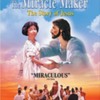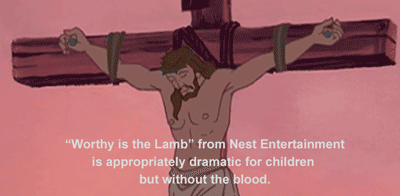Trial and Crucifixion
Video Lesson for Grades 3, 4 & 5
Summary of Lesson Activities:
Uses the video: "JESUS" from Inspirational Films Inc.
Scripture Reference:
Luke 23
Concepts:
- Even though he was accused of doing wrong, Jesus was innocent.
- Jesus is obedient to God.
Lesson Objectives:
- The children will learn the events of Holy Week according to the Gospel of Luke.
- The children will look for evidence of Jesus’ innocence.
Leader Preparation:
- Review the scripture.
- Review the video.
- Gather the materials.
- Prepare copies of the Brief Statement of Faith. Note: this is a subset specific to Jesus. Read the entire Brief Statement of Faith (approved by the General Assembly in 1991) concerning our triune God in the Book of Confessions.
- Have the video ready to go at the correct scene (see lesson).
- Pop the popcorn.
Materials List:
- Wooden cross necklaces – www.orientaltrading.com $1.95/dozen
- The Brief Statement of Faith for each child (see end of lesson).
- Glue sticks
- Jesus DVD (Search for on YouTube to preview this video. This video, In honor of its 35th anniversary, was re-mastered in high-definition with a complete new musical score. For more info check out The JESUS Film. )
Lesson Plan
Opening:
Greet the children and introduce yourself. Wear your nametag.
Explain the purpose of this workshop. This unit is a study of the Trail and Crucifixion. We will look at the main events that took place during Holy Week when Jesus was put on trial and crucified. We will look for evidence that Jesus was innocent of the crimes for which he was accused.
Dig:
Bible Story:
Say: Today when someone is accused of breaking the law he or she is charged with a crime or crimes.
Ask: What crimes was Jesus accused of committing? Gather ideas from the children. (If this is early in the rotation, they may not know. If later in the rotation, write down their ideas on the whiteboard.)
Do: Ask for a volunteer to read from Luke 23:1-2.
- Getting people to riot
- Telling people to stop paying taxes
- Claiming to be the Messiah or King.
Ask: Was Jesus guilty of these crimes?
Say: Today you are going to pretend that you are lawyers for Jesus. Watch the movie and look for evidence that might be used to show that Jesus was not guilty of these crimes. Also, look for actions that were used to make Jesus look guilty. A good lawyer needs to know what the prosecuting lawyers might use against our client Jesus.
Do: Distribute the popcorn with help from the Shepherds or volunteer children.
Start the video. It’s about 30 minutes long if cued to the beginning of the scene where Jesus enters Jerusalem on a donkey. Give the children a warning: the scene in which Jesus is crucified is very graphic and sad. If you need to, please close your eyes or look away.
Stop/pause the movie briefly at the scene when Jesus is brought before Pilate. Remind the children of the crimes for which Jesus was being accused.
Stop the movie at the end of the scene when Jesus is laid to rest in the tomb.
Application:
1. Briefly recap the sequence of events leading to Jesus’ arrest.
2. Discuss. What events occurred that might give the prosecutors a reason to think Jesus was guilty of the crimes? List them on the board. (See chart below.)
3. What events occurred that a lawyer might have used to defend Jesus against each accusation? List them on the board. (See chart below.)
4. Note that Jesus did not defend himself. Why? Jesus was obedient to God. He knew that he had to die on the cross in order to save our sins. Jesus paid the price for our sins – every one of us -- so that we are forgiven. Now nothing can separate us from God.
Write these headings across the top on the whiteboard:
Crime Yes, he is guilty No, he is not
Below each heading, gather the evidence to support guilt or not for each crime.
Crime: Getting people to riot
Yes - Overthrowing the tables in the temple
- Large crowds were following Jesus into Jerusalem and wherever he went (Luke 19:37-40).
No - The temple is a place for worship, not for making money. Jesus was right to be angry about this. - The crowds following Jesus were peaceful.
- Jesus healed the ear of a slave who came to arrest him and demanded, “No more of this” (Luke 22:47-53).
Crime: Telling people to stop paying taxes
No - Jesus could not be tricked into telling people not to pay taxes. Jesus said to pay to the emperor what belonged to the emperor and pay to God, what was God’s (Luke 20:20-26).
Crime: Claiming to be the Messiah or King.
Yes - The people praised Jesus and called him king when he entered the city (Luke 19:38).
No - When Pilate asked Jesus if he was king of the Jews, Jesus did not say yes. He said “You say so” (Luke 23:3).
- Jesus told his disciples not to tell others about who he really is (Luke 9:18-21). (This is not shown in the video but may be worth mentioning.)
Reflection:
- Say the memory verse together.
- Show the children one of the wooden cross necklaces. Explain that the cross is a symbol of the Christian church. It is not just a reminder of the cruel way that Jesus died, but something much better. Jesus died and paid the price for all our sins. That means that when we do something bad, we can ask for forgiveness and know that God loves us and forgives us. Nothing can separate us from God’s love. Point out to the children that the cross is empty; Jesus is not on it. After he was crucified, Jesus arose from the dead. The empty cross is a sign that Jesus has been raised from death into everlasting life and that we, as followers of Jesus, share in his new life. Jesus lives forever in us and in the church.
- Give each child a wooden cross necklace and the passage about Jesus from “A Brief Statement of Faith.” Put on the necklace and together recite the words that describe what we in the Presbyterian Church believe about Jesus. Ask the shepherds to pass out the journal sheets. Paste the passage from the Brief Statement of Faith onto the journal page. Draw a cross if you wish.
Prayer: Thank you God for sending your son to us. Even though Jesus was innocent of crimes, he died on the cross so that our souls can live forever. Thank you for your amazing love. Amen.
References:
- Inspirational Films Inc. - Jesus. Distributed by: JVPOA, 3508 Cheshire Drive, Birmingham, AL 35242-3100. (A Genesis Project Production) www.visionvideo.com
- Book of Confessions, Study Edition. Part 1 of the Constitution of the Presbyterian Church (U.S.A.). Geneva Press: Louisville, Kentucky.
From A Brief Statement of Faith
We trust in Jesus Christ,
fully human, fully God.
Jesus proclaimed the reign of God:
preaching good news to the poor
and release to the captives,
teaching by word and deed
and blessing the children,
healing the sick
and binding up the brokenhearted,
eating with outcasts,
forgiving sinners,
and calling all to repent and believe the gospel.
Unjustly condemned for blasphemy and sedition,
Jesus was crucified,
suffering the depths of human pain
and giving his life for the sins of the world.
God raised this Jesus from the dead,
vindicating his sinless life,
breaking the power of sin and evil,
delivering us from death to life eternal.
A lesson written by Kirk of Kildaire Presbyterian Church
Cary, NC
This lesson is copyrighted by the Kirk of Kildaire Presbyterian, Cary, North Carolina








